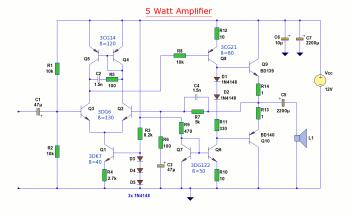The following is the diagram of 5W audio amplifier circuit which built using power transistor BD139 and BD140 as the final gaining process. This small amplifier can be used as general purpose amplifier such as computer amplifier, radio, mp3 player, video player, etc.
Input Stage
The input stage consists of Q1 through Q5 and 3 diodes. The differential pair is biased by Q1, R3, R4, D3, D4, and D5. The biased current is set to 1 mA. Q4 and Q5 form a current mirror as the active load for the differential pair, and the output is taken out single-endedly from the collector of Q2. The open loop gain of the input stage is more than 60dB.
Second Stage
Q8 act as a common-emitter amplifier driving the output stage. Current mirror formed by Q6 and Q7 serve both biasing current source and active load for Q8. The open loop gain of the second stage is about 40dB. Q6 and Q7 are mounted together inside the blue tube to provide thermal compensation to each other.
Output Stage
The complimentary pair BD139/140 is biased by D1, D2, and R10. Adjusting the value of R10 can yield the desired quiescent current. R13 and R14 prevent thermal run-away of the complementary pair. DC voltage at the output is always half the power supply.
Feedback
The feedback network consists of R6, R5, C3 and C4. The overall gain is about the ratio of R6 to R5. C4 provides lead compensation; C3 provides DC-blocking.
Frequency Response
The cut-off frequency is determined at the upper end by C2, R5, and C4, and at the lower end by C1, C3, and C5.
Power
Power supply voltage 12V, 5W for a 4 ohm speaker, 3W for an 8 ohm speaker.
5W audio amplifier circuit page source: http://www.zen22142.zen.co.uk/Circuits/Audio/5w12v_amp.htm
Input Stage
The input stage consists of Q1 through Q5 and 3 diodes. The differential pair is biased by Q1, R3, R4, D3, D4, and D5. The biased current is set to 1 mA. Q4 and Q5 form a current mirror as the active load for the differential pair, and the output is taken out single-endedly from the collector of Q2. The open loop gain of the input stage is more than 60dB.
Second Stage
Q8 act as a common-emitter amplifier driving the output stage. Current mirror formed by Q6 and Q7 serve both biasing current source and active load for Q8. The open loop gain of the second stage is about 40dB. Q6 and Q7 are mounted together inside the blue tube to provide thermal compensation to each other.
Output Stage
The complimentary pair BD139/140 is biased by D1, D2, and R10. Adjusting the value of R10 can yield the desired quiescent current. R13 and R14 prevent thermal run-away of the complementary pair. DC voltage at the output is always half the power supply.
Feedback
The feedback network consists of R6, R5, C3 and C4. The overall gain is about the ratio of R6 to R5. C4 provides lead compensation; C3 provides DC-blocking.
Frequency Response
The cut-off frequency is determined at the upper end by C2, R5, and C4, and at the lower end by C1, C3, and C5.
Power
Power supply voltage 12V, 5W for a 4 ohm speaker, 3W for an 8 ohm speaker.
5W audio amplifier circuit page source: http://www.zen22142.zen.co.uk/Circuits/Audio/5w12v_amp.htm

No comments:
Post a Comment